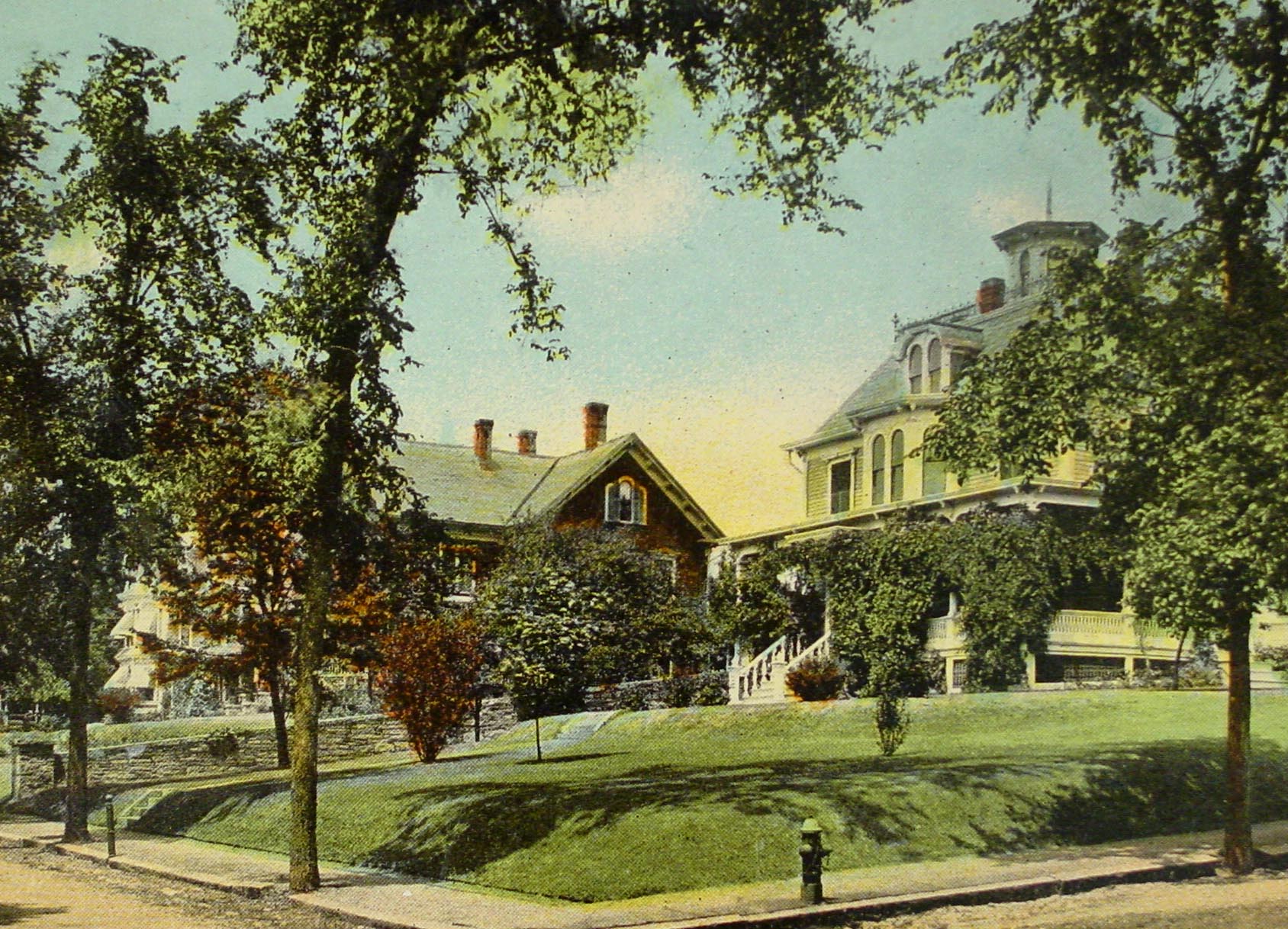History of Willimantic, The Thread City
 |
|
Willimantic's earliest mill dams were located at natural waterfalls. Another great advantage of the river was the presence of granitic-gneiss outcroppings along its banks, a source of stone for building the early mills. |
According to folklore, the name "Willimantic" is derived from an Indian word meaning "Place of the Swift Running Waters," an apt designation for this locality. The waters of the Willimantic River drop some 90 feet in a little over a mile, making the place an ideal location for water-powered enterprises. Even before there were any textile mills, the Willimantic River had been harnessed to power gristmills, sawmills, a powder mill that supplied the Continental Army during the Revolutionary War, a paper mill, and an iron works. These mills were all small-scale, employing but a handful of workers. Nevertheless, they pointed the way to what would become Willimantic's first great engine of growth, water-powered manufacturing.
The first to exploit the waterpower of the Willimantic River for textile manufacture was Perez Richmond, a Rhode Islander who in 1822 built a small wooden cotton mill near where the Natchaug River joins the Willimantic. The mill and the houses that were built for the millworkers created a village at the site that became known as Richmond Town. When the ownership of the mill changed, the village's name changed, too, to Wellesville. The mill was eventually incorporated into the operations of the Willimantic Linen Company.
 |
|
This 1836 view, looking north on Bridge Street, shows three large cotton mills (arrows). |
Also, in 1822, Charles Lee purchased a mill privilege on the east side of present-day Bridge Street and erected a large stone cotton mill. The mills were later known as the Smithville mills. Meanwhile, Matthew Watson, Nathan Tingley, and Arunah Tingley of Providence, R.I., purchased water rights and land just upstream on the west side of Bridge Street. Where earlier there had been a sawmill and gristmill, Watson and the Tingleys built a large stone mill to manufacture cotton cloth, along with houses for themselves and their workers. The Windham Cotton Manufacturing Company, as their enterprise was called, prospered and remained a major textile producer well into the 20th century. In 1907, the mills on both sides of Bridge Street were combined into a single operation. Today, the mills at this location are gone, though two dams, some foundations, some of the mill-worker houses, a former storehouse and a former company store remain standing.
Another successful investment in textile manufacturing was that of William, Asa, and Seth Jillson of Dorchester, Massachusetts. The Jillson Brothers cotton mill was built in 1824 near the present-day Jackson Street bridge (the "Frog Bridge") and its foundations can still be seen today. The mansion of William Jillson is the stone house maintained by the Windham Historical Society. The Jillson mill later became the spool-making shop of the Willimantic Linen Company.
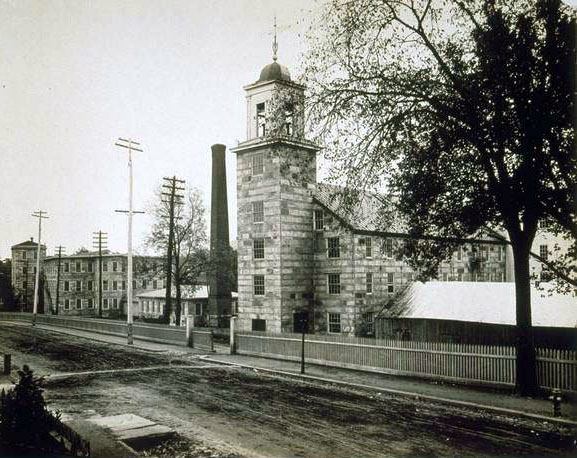 |
|
The original Jillson Mill was later used by the Willimantic Linen Company as its first spool shop. In the 1880s, the company built a spool factory in Willimantic, Maine, to supplement the local shop's output. The Linen Company's Mill No. 1 is visible at the left. |
In 1854, a group of Hartford investors, led by Austin Dunham and Lawson Ives, bought the old Jillson cotton mill with the intent of manufacturing linen. Shortly after they commenced operations, the Crimean War (1854-1855) interrupted the supply of European flax that the company had been counting on, and so the company switched to another specialty product, cotton thread for sewing machines. With expertise from thread-production managers from a mill in nearby Willington, the Willimantic Linen Company quickly became a leader in what would prove to be a tremendous growth industry. Prior to this time, thread wound on spools only came in black or white; colored thread was available in bulk skeins only. But from the beginning the Willimantic company offered spooled thread in a wide variety of colors, appealing to two growing segments of the economy: the emerging ready-to-wear clothing industry, centered in New York City's garment district, and the rising popularity of home sewing using Singer, Wheeler and Wilson, Howe, and other innovative sewing machines. The major sewing-machine manufacturers endorsed Willimantic thread and recommended it to their customers, and the company itself advertised far and wide, often piggy-backing on current events such as the acquisition of Jumbo the Elephant by Barnum's circus and the opening of the Brooklyn Bridge. Business was so good that in 1879 the company decided to buy property in Howard, Maine, close to the source of timber used to make its wooden spools, where it erected a large woodworking factory. In 1881, Howard was renamed Willimantic, the name that it continues to bear today.
In order to keep up with the ever-increasing demand for its product, the Willimantic Linen Company constantly expanded its manufacturing facilities. In addition to earlier mills acquired and merged into its operations, the company built additional huge granite mills in the 1850s and 1860s, along with new tracts of worker housing. Accompanying the expanded plant was Dunham Hall, built in 1867 as a company store and library for the workers, and today the home of the Mill Museum.
In 1880, the Willimantic Linen Company completed Mill No. 4, a huge brick factory, 168 feet wide by 840 feet long, that was, at that time, the largest cotton mill in the world. In addition to its size, Mill No. 4 was ahead of its time in other respects: its interior lighting used electric lamps instead of gaslights, all the belting and shafting were accommodated in conduits under the floor instead of overhead (both an aesthetic and safety improvement), and the mill was a single story in height, prefiguring the industrial architecture of the 20th century. People came from all over the world to see it. At the same time, the company built stylish new single-family cottages for the anticipated growth in its workforce. Unlike the earlier rows of plain, identical tenements, "The Oaks" used a variety of designs; the appearance and comfort of the homes received national attention as a model of industrial housing.
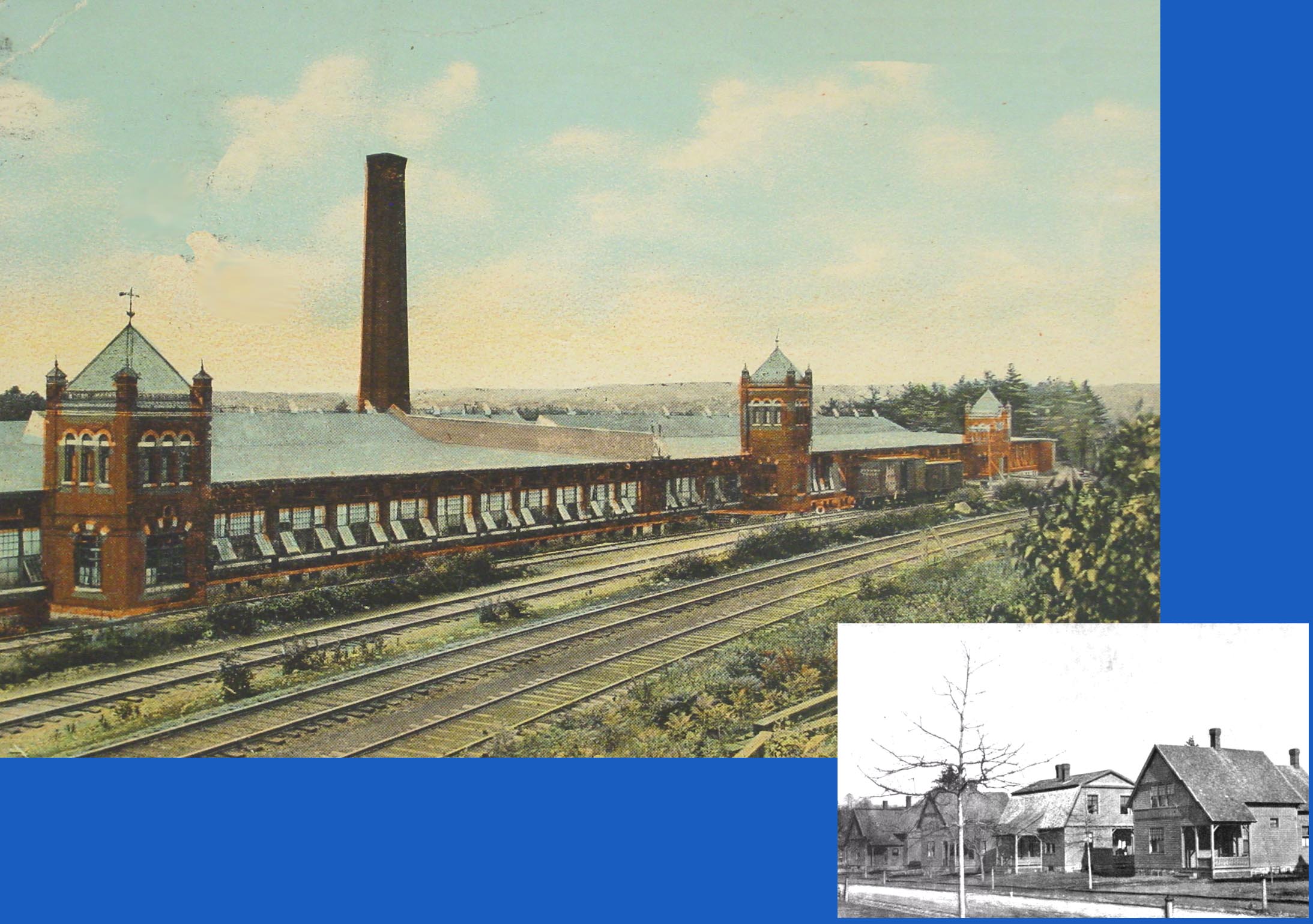 |
|
Mill No. 4, built on the south side of the river in 1880, the largest cotton mill in the world at the time. Inset: "The Oaks" cottages in 1895. |
In 1898, the Willimantic Linen Company became part of the American Thread Company, a large corporation that was attempting to gain a dominant position in the international market for thread. Under its ownership, Mill No. 4 finally reached its full productive potential, and in the early 20th century other large brick mills and a huge reinforced-concrete warehouse were added to the plant. American Thread remained a major employer in Willimantic through the 1980s.
Although the dams on the Willimantic River created plenty of power, there was nowhere within the city to create millponds behind the dams. Millponds were essential to even out the flow during times of low water. Typically, a mill would draw down water from its millpond during the day, then let it fill back up at night. In order to create "pondage," as it was called, Willimantic manufacturers acquired control of the Hop River, a major tributary of the Willimantic River. The Bolton Lakes, formerly known as Willimantic Reservoir, and Columbia Lake were managed as pondage for the mills of Willimantic.
 |
|
The Holland Silk Company on Valley Street began operation in 1866 and at its height employed more than 200 people. |
|
|
 |
|
Forty trains a day made the Willimantic train station a busy place. |
Cotton-cloth and thread manufacturing were Willimantic's major industries, but there were numerous other manufacturing enterprises as well. While not nearly as large as the cotton and thread mills, the city's several silk factories employed hundreds of people. The first silk mill opened in 1860, and the last closed its doors in 1941. Willimantic at one time or another was also host to machine shops, woodworking factories, and commercial printing presses.
At first, Willimantic was more of a collection of mill villages along the river rather than a single distinct settlement, but the presence of the mills continued to attract people and businesses to the area and gradually the spaces between the mills were filled in. In 1833, the residents of Willimantic received a charter from the state legislature that established the place as an incorporated borough. Although it remained part of the larger town of Windham, Willimantic had its own government, a Board of Burgesses, and was empowered to tax its residents to pay for services such as improved streets and fire protection. At the time of its incorporation, Willimantic had about 2,000 residents.
Another major historical development that made Willimantic into a small city was the coming of the railroad. In 1849, the tracks of the New London, Willimantic, and Palmer Railroad were completed, linking Willimantic to the coastal line that ran to New Haven along Long Island Sound and to points north. Shortly thereafter, an east-west route, the Hartford, Providence & Fishkill Railroad, ran through Willimantic, connecting it to two of southern New England's largest cities. Willimantic became a railroad junction, the largest rail center in eastern Connecticut.
Railroad connections encouraged the development of wholesale and retail businesses serving not only Willimantic but the entire eastern Connecticut region. Coal, lumber, feed, farm equipment, groceries, architectural millwork-these are just a few of the businesses that relied on Willimantic's railroad facilities to bring in merchandise. In the 1870s, the two earlier rail lines were joined by a third, the so-called "Air Line" (i.e., as the crow flies) route between Boston and New York. A cluster of hotels and restaurants developed around the passenger depot, and Main Street and the side streets off Main became a dense concentration of businesses offering all kinds of goods and services. The Hooker Hotel, opened by Seth C. Hooker in 1884 (now known as Windham House) was in its day a state-of-the-art hotel, with every modern convenience:
 The Hooker House is pre-eminently one of the finest hotels in eastern Connecticut, and perhaps the finest. It is a substantial four-story brick building, the interior arrangement of which is a marvel of convenience and economy. Corridors nine feet wide run through the center of the building on each floor, and a hydraulic elevator, steam heat, hot and cold water, electric bells and speaking tubes, are among the modern advantages in the generally complete equipment. There are one hundred chambers of uniform size, and the eating and sleeping accommodations are first-class in every respect. (Bayles, History of Windham County, 1889).
The Hooker House is pre-eminently one of the finest hotels in eastern Connecticut, and perhaps the finest. It is a substantial four-story brick building, the interior arrangement of which is a marvel of convenience and economy. Corridors nine feet wide run through the center of the building on each floor, and a hydraulic elevator, steam heat, hot and cold water, electric bells and speaking tubes, are among the modern advantages in the generally complete equipment. There are one hundred chambers of uniform size, and the eating and sleeping accommodations are first-class in every respect. (Bayles, History of Windham County, 1889).
Perhaps feeling the competition, an older hotel, the Brainerd House, added "No Old Furniture - Everything New" to its advertisements, in which it referred to itself as "The Old Reliable."
|
Willimantic businesses advertised a wide variety of goods and services in the 1890s. Click for more examples.
|
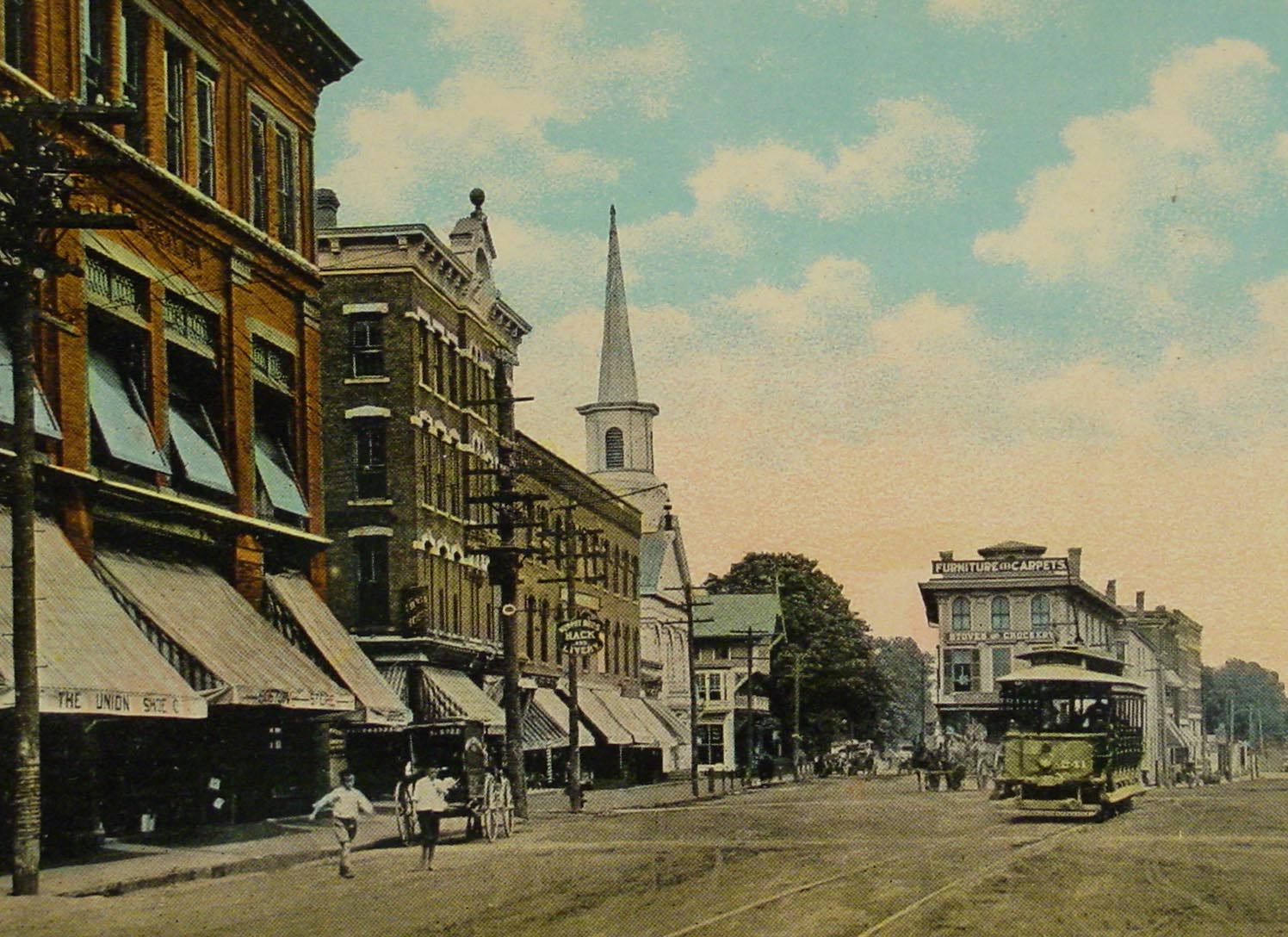 Turn-of-the-century Main Street was lined with large commercial blocks; in this view, a trolley has started its west-bound run. Willimantic's merchants built large Victorian houses along the shady streets of the Hill neighborhood.
|
In addition to its industrial and commercial preeminence, Willimantic served as a financial, educational, and judicial center not only for Windham but for all the surrounding towns. For example, the agricultural towns in the area-Mansfield, Columbia, Lebanon, Franklin, Scotland, Chaplin, Ashford, Hampton-were all too small to support banks, yet Willimantic had several: the Windham Bank founded in Windham Center in 1842 and relocated to Willimantic in 1879; the Willimantic Savings Institute, also founded in 1842; the Merchants Loan & Trust Company, 1871; the Dime Savings Bank, 1872; and the First National Bank, 1878.
 |
|
The Willimantic State Normal School was the forerunner of today's Eastern Connecticut State University. |
When the Willimantic State Normal School was established in 1889, it was one of only two teacher-training colleges in the State. At first, classes were held in the upper rooms of the Willimantic Savings Institute Building, but in 1895 a large new college building, with modern classrooms, library, and laboratories, was built on land donated by the town of Windham. Education remains an important part of the institution's mission, but Eastern Connecticut State University, as it is now known, supports a variety of other undergraduate and Master's Degree programs as well. Another educational institution that drew people to Willimantic was its high school. Few of the nearby towns could offer anything beyond the one-room schoolhouse, so children wishing to further their education came to Willimantic. At first, the high school was accommodated in rooms in the three-story Natchaug School; this is where Mansfield resident Wilbur L. Cross studied before going on to Yale and a career as a distinguished professor of literature (before serving as Governor of Connecticut in the 1930s). In 1897, a new building with all the latest features was built for the high school.
 |
|
In addition to town and city government, Windham's Town Hall originally accommodated country court proceedings and a G.A.R. hall. |
Willimantic's importance was enhanced in 1897 when a large and elaborately detailed courthouse was completed to accommodate the proceedings of the Windham County Court. The building, designed by noted Bridgeport architect Warren R. Briggs, was built of brick (more than a million of them) with granite trim from Munson, Massachusetts, and it cost $73,000, a fortune at the time. In addition to courtrooms, the building provided a hall for the Grand Army of the Republic, a Civil War veterans' group, and offices for the Town of Windham and the City of Willimantic (a charter revision in 1893 had changed Willimantic's status from a borough to a city in 1893; in 1983 the town and city governments were consolidated).
 |
|
People crowd around a streetcar on the inaugural run to Coventry Lake. |
In 1903 the Willimantic Traction Company introduced streetcar service to Main Street. At the east end, riders could change cars to take electrified cars to Taftville and Norwich, and eventually service at the west end was extended to Coventry Lake, where there was a small amusement park. At one time, Willimantic residents could even ride the trolley all the way to the beach in Westerly, R.I., with just one change in Norwich. The streetcars were generally a boon to the community, but they also added to the congestion and dangers for pedestrians posed by the frequent railroad trains and other downtown traffic. As a result, Willimantic in 1906 built a pedestrian footbridge over the Willimantic River and the railroad tracks so people could safely walk from the downtown to the residential neighborhoods on the south side of the river.
Like other small cities of its size, Willimantic had a huge number of community organizations in the late 1800s and early 1900s. These included sports teams organized by the mills and other companies; ethnic organizations catering to people of Irish, French-Canadian, and Scandinavian heritage; church-affiliated men's and women's clubs; bands, orchestras, and musical groups; and workers' organizations such as the Knights of Labor and railroad-employee brotherhoods. The mills maintained recreational parks for their employees. The Windham Company's park became what today is Memorial Park, and the American Thread Company's park became Rec Park.
Willimantic in the late 19th and early 20th centuries was a thriving, vibrant place with plenty of work in the textile mills and other factories, numerous wholesale and retail businesses, theaters and restaurants, several hotels, and various amenities that drew people into the city from miles around.
Willimantic History Resources on the Web
Willimantic History Bibliography.

